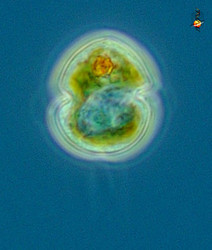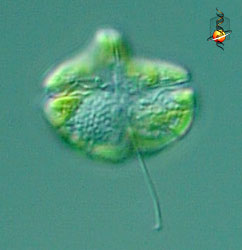Haptophores
- Karlodinium
- Karenia
- Takayama
Title Illustrations

| Scientific Name | Karlodinium micrum |
|---|---|
| Comments | Karlodinium micrum has an equatorial flagellum lying in a groove (girdle or cingulum) near the centre of the cell and a second flagellum trailing behind the cell and arising in a longitudinal groove or sulcus. The large gray area posterior to the girdle is the nucleus. The orange element is probably a residue from ingested food (Rhodomonas). |
| Acknowledgements | This image is of material from Provasoli-Guillard National Center for Culture of Marine Phytoplankton |
| Source | Karlodinium micrum |
| Source Collection | Micro*scope |
| Image Use |
 This media file is licensed under the Creative Commons Attribution-NonCommercial-ShareAlike License - Version 2.5. This media file is licensed under the Creative Commons Attribution-NonCommercial-ShareAlike License - Version 2.5.
|
| Copyright | © Bob Andersen and D. J. Patterson |
| Scientific Name | Karenia brevis |
|---|---|
| Comments | Karenia brevis, small gymnodinioid dinoflagellate, cell with equatorial groove or girdle containing one flagellum, a second flagellum trails behind the cell. With golden chloroplasts, and large globular nucleus in posterior part of the cell, in this image showing the condensed chromosomes. |
| Acknowledgements | This image is of material from Provasoli-Guillard National Center for Culture of Marine Phytoplankton |
| Source | Karenia brevis |
| Source Collection | Micro*scope |
| Image Use |
 This media file is licensed under the Creative Commons Attribution-NonCommercial-ShareAlike License - Version 2.5. This media file is licensed under the Creative Commons Attribution-NonCommercial-ShareAlike License - Version 2.5.
|
| Copyright | © Bob Andersen and D. J. Patterson |
About This Page
This page is being developed as part of the Tree of Life Web Project Protist Diversity Workshop, co-sponsored by the Canadian Institute for Advanced Research (CIFAR) program in Integrated Microbial Biodiversity and the Tula Foundation.
Page copyright © 2008
 Page: Tree of Life
Haptophores.
The TEXT of this page is licensed under the
Creative Commons Attribution-NonCommercial License - Version 3.0. Note that images and other media
featured on this page are each governed by their own license, and they may or may not be available
for reuse. Click on an image or a media link to access the media data window, which provides the
relevant licensing information. For the general terms and conditions of ToL material reuse and
redistribution, please see the Tree of Life Copyright
Policies.
Page: Tree of Life
Haptophores.
The TEXT of this page is licensed under the
Creative Commons Attribution-NonCommercial License - Version 3.0. Note that images and other media
featured on this page are each governed by their own license, and they may or may not be available
for reuse. Click on an image or a media link to access the media data window, which provides the
relevant licensing information. For the general terms and conditions of ToL material reuse and
redistribution, please see the Tree of Life Copyright
Policies.
- First online 05 August 2008
- Content changed 05 August 2008
Citing this page:
Tree of Life Web Project. 2008. Haptophores. Version 05 August 2008 (temporary). http://tolweb.org/Haptophores/126800/2008.08.05 in The Tree of Life Web Project, http://tolweb.org/










 Go to quick links
Go to quick search
Go to navigation for this section of the ToL site
Go to detailed links for the ToL site
Go to quick links
Go to quick search
Go to navigation for this section of the ToL site
Go to detailed links for the ToL site